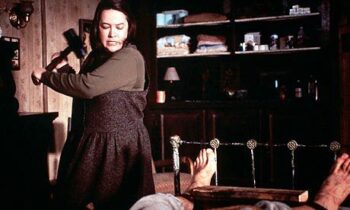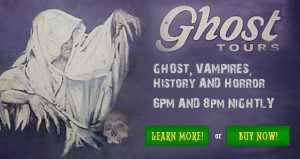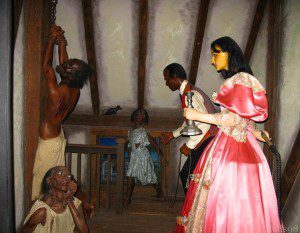
I came home from work the other day and found a notice taped to my front door. It had the logo for the FX television series American Horror Story on it and announced they would be filming on my block that weekend. It gave information about dates, parking and traffic restrictions, and people to contact in case of a problem. One number was for the Mayor’s Office of Film and Video, which, the letter said, could “verify (the) credentials” of the production. We were also assured that “Law Enforcement Officers” would be on hand to help things run smoothly. It was a relief to learn that horror is so well managed and courteous in New Orleans, certainly a far cry from my childhood days.
The shoot made for a fun evening in the neighborhood. It was cool as they set up the lights on the narrow sidewalks. Neighbors came out with cocktails and stood behind the yellow tape, looking out for stars—Kathy Bates or Jessica Lange—and chatting about horror. Nothing much happened before we went to bed, and it was a quiet night. I slept soundly until my neighbor’s rooster woke me up around 5:30 a.m. I went out on my stoop in my robe and saw most everything was gone. There was still one big light on a rolling scaffold on the corner. A couple of security guards leaned on it, looking tired. They were unarmed , and wore khakis and polos. They resembled Best Buy employees. Further down the street was a house with heavy black plastic hanging over half of it. Workmen came out of it with rolls of cable to toss into the back of a lone truck. It was odd to see no cars on the block, but the parking restrictions had cleared the street and the neighbors hadn’t woken up to move their cars back yet. It was enough to provoke a sense of the uncanny, and my imagination began to drift.
I knew the guy who owned the house with the black plastic over it, and I saw him chatting with the crew worker in the truck. I went over and he told me they’d done an interior scene in the unrented half of the double shotgun house. Many of the houses in the neighborhood are double shotguns, interspersed with single shotguns, side hall cottages (with the open gallery on one side), and Creole cottages on the corners. Shotgun houses are comprised of a narrow series of rooms connecting directly, with no hallway. The pattern is usually three rooms, the kitchen, and a back bedroom with doors leading to the sole bathroom and the backyard. I grew up in one of these. I don’t know if it’s my personal history or the design of the homes, but something about the rooms just going into one another in a row with no hallway makes them seem like dream rooms, like you’re suddenly in the next room, which looks a lot like the one you were just in, though just slightly off.
My friend Mike’s double shotgun is raised about four feet off the ground. Each side has its own little concrete porch and railing. He stood on the little porch and asked me if I wanted to see where they filmed inside. He asked the workmen, who were still dragging gear out, and they said it was fine as long as I didn’t take pictures.
The first couple of rooms were clean and empty, ready to show to prospective renters, with white-washed walls and mantels, high ceilings and fans, high narrow windows, and wooden floors. The next room was furnished. It was the dining room. There was a common wooden table and chairs in the middle, a dresser against a wall, and black and white framed family photos on the mantle. The wallpaper was a brownish red, and, on closer inspection, not applied very carefully, not trimmed neatly along the ceiling line. I gathered we had wandered back as far as the mid-20th Century. The next room was the kitchen. It had a sink (with no plumbing underneath), a rustic white wooden china cabinet, and a stove that struck a chord in my memory: it was the exact kind of stove we had in the shotgun house of my early childhood. It was up on legs, with burners on one side and broiler and oven right next to them, instead of under. The finish was the same white and green swirl baked right into the metal.
The rear bedroom was the scene of the horror. Blood splattered everywhere. Pooled in big splotches on the narrow bed and on the floor next to it. The rear door had a broken panel, so you could see the back steps leading down into the yard. My neighbor explained to me that the broken panel was where the axe murderer had gotten in. No, the blood didn’t look real. But the house looked real, which is different than how an axe murder crime scene appears on TV. Lighting, framing, etc, the camera itself, create that distance that can make an axe murder fun. Maybe it was the four walls around me that creeped me out. Especially since the four walls of this shotgun house rear bedroom were so familiar. Though I was never in this particular apartment, it could have been the same room as numerous other rooms I had spent time in, time enough to seed the fabric of my earliest memories and lifelong dream geography. I felt the horror, faint but firm, from some deep-seated interior room that had been locked for years.
When I was in fourth grade, one of my classmates disappeared and was found later, chopped up in a garbage bag. It happened in a house like this. She was a girl, named Ingrid. Black girl. She used to wear her hair combed tightly into pigtail twists with those big plastic marble elastics to secure them. She was a bit bigger than the other girls, and had a little paunch. We weren’t close, yet I can picture her better than almost all my other classmates of that year. I even have a clear memory of her dad, a guy I never formally met, and I can’t remember any of my other classmates’ parents. She was missing for a few days and the school was involved in putting out the word, helping with the search. It turned out it was her next door neighbor that got her. With the grisly news of the outcome, the fleeting images of a few days must have seared themselves deep inside me, to stay forever.
Just a couple of weeks ago, I was at a funeral for a dear friend taken finally by disease in old age, and I noticed a stone with her name on it, my murdered classmate. I hadn’t ever known where she was buried, but there was the memorial. Apparently she died just days before her birthday. She was probably looking forward to her happy day, to promised gifts and a party. Before the Lord decided to subject her to a special kind of hell that only He is capable of devising.
I was watching the Catholic channel one day and they were asking a priest about the position of the church on ghosts. He reported how Catholic teaching holds that there is a finality to death—no survival of the soul as a ghost wandering earth—and said that people probably invented ghost stories to take the terror out of death. A consideration of ghost tourism in New Orleans would seem to confirm that view. Everybody knows that New Orleans is famous for its ghosts; indeed, in the words of one tourist website, it is “America’s Most Haunted City.”
But that’s not good. It means there are more unhappily dead people here than anywhere else. On the one hand, we have personal memories and statistics to scare the BeJesus out of us (if we dwell too much on unpleasant details). On the other hand, we get to reap the fun that our sublimation of that terror results in. Aestheticized horror and the genuine article go hand in hand. The wicked witch of a history of cruelty and the good witch of the erotically charged voyeuristic thrill that aestheticized horror provides. Add race to the mix and you have the peculiarly American horror called “the South.”
Ghost tours in New Orleans have boomed in the past twenty years. So much so that French Quarter residents file frequent complaints about the drunken crowds lapping up the tour guides’ lurid tales on the darkened street corners of the safest part of town. A routine stop is at a house that I was warned away from by neighbors in my childhood. The house of Madame Delphine LaLaurie stands on the corner of Royal and Governor Nichols. Nicholas Cage owned it for a while, but then he went mysteriously bankrupt and had to sell. The actual Madame LaLaurie was a white Creole society woman who often entertained at the mansion. She would reportedly excuse herself periodically and the guests would pretend not to hear the muffled cries from above. She had a torture chamber in her attic—just for kicks—where she kept slaves chained and undernourished for purposes of recreational cruelty. Until one day a little girl, fleeing Madame’s blows, leapt to her death in the courtyard below. The resulting community outrage led her to flee New Orleans, first to New York, then to France, but the FX version leaves out these details. Madame LaLaurie is played by Kathy Bates in American Horror Story: Coven.
I don’t like Bates in the role, but that’s not a professional opinion. The reasons are very personal. Madame LaLaurie is someone I saw often as a child, and she always filled me with the kind of magnetic terror that forms the basis of aestheticized horror, if only it can be kept at a safe emotional distance. I walked by her house and thought of her, however briefly, almost every day of my childhood. I noticed how other people would sometimes cross themselves when they went by it. And I saw her in person, in raven hair and a rich pink evening gown, with candle in one hand and a whip in the other. It was at the Musée Conti, the wax museum, where to this day she raises her hand against helpless chained starving victims, as long as the air conditioning holds up (blessedly, they had a generator for Katrina).
The Musée Conti depicts her as strikingly beautiful, as she hisses threats in the dim light. In front of her are two chained adults, a standing man and a woman on the ground. The man’s hands are shackled high above his head, and the woman seated on the ground has one wrist chained tightly to her neck. Both are emaciated, both twisting their heads to look at her—which can only mean she’d commanded them to. They’re black, but so is the well-dressed butler, next to Madame, who brandishes a rope for the little girl running toward the stairs. The eyes of the chained adults, whom I always imagined to be the girl’s parents, bulge out of their sallow faces as they twist to heed the famous cruel beautiful white woman in the elegant dress.
As a lagniappe, the Musée Conti’s New Orleans history exhibit is followed by the “Haunted Dungeon,” a series of middlebrow Hollywood horror scenes, from Frankenstein to Dark Shadows. But none of them compare to Madame LaLaurie’s attic, which captures so succinctly the emotional essence of slavery as the handmaiden of sadism. Sadism is, of course, the thrill tapped into by aestheticized horror—the erotic kick of watching other people terrorized. The fact that it’s in the history section of the museum is a stark link between a history of horror and the horror industry. Contrary to Freud’s “talking cure,” though, reliving the trauma doesn’t exorcize it, though it does lead to rituals of aestheticized re-enactment that must serve some emotional purpose. Sometimes, as in American Horror Story, the result is an erotic form of fun. In other cases, there are other intended purposes, though I wonder if emotional results can be accurately generalized and predicted.
Steve McQueen’s Oscar-winning Twelve Years a Slave also puts cruelty on the screen, though the intended effect is supposed to be revulsion rather than aesthetic pleasure. Since the 1970s, graphic depictions of historic American racist violence have also come to be a kind of ritual in movies not intended to be “horror” films. But some aesthetic affinities are hard to ignore. Hollywood South regular James Franco made that clear enough in his own review of Twelve Years a Slave: “We like watching humans get beaten, and if such beatings are framed in the right way, in this case, in an important film about American history, then we will lap up all that brutality and want more. I know I did.”
I think Franco’s basically right, as long as we see the “important film about history” part as a thin fig-leaf for indulging our sadistic fantasies. More generic horror movies, without claims to social uplift, are perhaps more honest. The other problem is that the aesthetic appreciation of scenes of brutality can easily be ruined by emotional discomfort, and distance from the experience of actual horror might be a pre-condition for enjoyment of aestheticized horror. Unless, of course, a cathartic effect is possible, the purging of repressed emotions in a controlled environment, sometimes a social one. This is probably the purpose of films like Twelve Years a Slave. But it also can’t be ruled out that more “fun” shows like American Horror Story don’t also function on that level. At any rate, both films’ intended effects rely on the viewer’s ability to maintain emotional distance from the subject matter. Those Americans who opine that Twelve Years a Slave made them see or feel for the first time the terror of slavery have obviously spent a lifetime not feeling some form of that terror already. Because of my New Orleanian upbringing, however, because of the palpable presence of Madame LaLaurie’s legacy, and because of the more random racial identity of my murdered childhood classmate, I developed at a young age a painfully emotional sense that there was something terrifying (and not in a fun way) about being black in America.
One night this past fall, when Twelve Years a Slave was being screened and American Horror Story was being shot, edited, and aired, seven young men broke into a dilapidated antebellum mansion in Arabi, an older, immediate suburb of New Orleans. The newspaper reported that their original purpose was to smoke marijuana and search for ghosts. But before they left, they set the old Lebeau Plantation alight and it burned to the ground. Community outrage naturally ensued, since one of the area’s oldest cultural landmarks, which had stood since the 1850s, was now destroyed. In the film version of Anne Rice’s Interview with the Vampire, the young vampire Louis de Pointe du Lac burns down his family’s plantation home because, as he tells his rebellious slaves, it’s been occupied by the devil. Who’s to say the LeBeau plantation wasn’t also? Who knows what psycho LaLaurie activities went on there? Being from New Orleans means living with the paradox of beauty rooted in blood. Are we to be sad or triumphant when some lovely torture chamber with wide galleries and stately columns burns to the ground?
It’s not that New Orleans or the south is unique in the interconnection between suffering and sublimated aesthetic enjoyment. As Walter Benjamin put it a hundred years ago, “There is no document of civilization that is not also a document of barbarism” (Benjamin, Illuminations, 256). It’s just that Americans have designated the south, perhaps especially New Orleans, as the anti-Jerusalem of American sin, therefore American horror. The problem with being from New Orleans is that there isn’t sufficient emotional distance to enjoy it.






